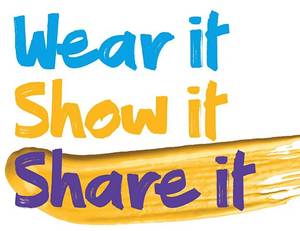Once upon a time consistency was king. But at a recent Brand Breakfast on visual identity design, “flexibility” was the word of the day; how clearly defining the elements that make up your visual identity will enable you to design all manner of communications across channels and products, from a Macmillan coffee morning to a London Air Ambulance!
Here we look at the elements that make up a flexible identity with some strong examples of best practice.
Logos and favicons
Once the be-all and end-all, neatly positioned in the corner of printed communications, logos were hardly mentioned during the presentations.
 There are two main options. A logotype (or wordmark) made up of distinctive typeface, or a logotype together with a symbol, whether obvious or abstract. Charity sector brand design is dominated with more obvious symbols from heartbeats to children, animals, birds and flowers, but there are also good examples of distinctive logotypes such as the Parkinson’s UK stencil and Stroke Association’s “Action” front inspired by art therapy, or Walk Through Walls, a new charity which looks to help human trafficking victims “overcome obstacles” by providing job opportunities.
There are two main options. A logotype (or wordmark) made up of distinctive typeface, or a logotype together with a symbol, whether obvious or abstract. Charity sector brand design is dominated with more obvious symbols from heartbeats to children, animals, birds and flowers, but there are also good examples of distinctive logotypes such as the Parkinson’s UK stencil and Stroke Association’s “Action” front inspired by art therapy, or Walk Through Walls, a new charity which looks to help human trafficking victims “overcome obstacles” by providing job opportunities.
These days one logo format won’t be enough. You’re likely to need a ‘shortcut’ (or ‘favicon’) for social media purposes and apps, and an animated version for moving image content end-frames. Google is the best example here with its animating “G” short-cut and corporate multi-coloured wordmark which can be flexed creativity to celebrate days of the year. Cancer Research UK’s dynamic “C” also does this well.
Graphic devices
The focus of the presentations was on graphic devices, shapes or visual elements that help to make a brand instantly recognisable, even when the logo is covered up. Examples shared included Macmillan’s brush stroke and St John Ambulance’s chevron. Others that spring to mind are Save the Children’s simple circles, which compliments its logo, or Action for Children’s new identity which is based on flow diagrams. Good corporate examples come from the telecoms industry such as O2 with its floating blue bubbles or Vodafone’s red arrow. For me, not having a good graphic device is where a lot of charity design falls down.

Colour
Every charity brand would love to own a colour like Cadbury or EasyJet. On my second day as Shelter’s brand manager, I was told by the fundraising director that our marathon vests had to be yellow, even though the corporate colour was red!
This is where market analysis and a colour wheel come into play, as well as thinking about what different colours signify in terms of projecting the right personality. In the sector, Amnesty International stands out for its strong use of yellow and black.
Typography
While many brands will search for a typeface that reflects the right personality and accessibility, others will invest in creating something bespoke or tailor an existing font. Macmillan’s headline font is the best charity sector example. Other good examples come from culture and the arts; Channel 4, which is based on the shapes within its logo, and the new Southbank Centre typeface, inspired by its brutalist architecture.
It’s important to consider a headline and body copy font across print and digital channels, the use of more “SHOUTY” upper or friendlier lower case, serif or sans-serif, with or without extending features such as Times New Roman and Helvetica. Having a common default font for use on people’s personal computers or Microsoft templates is also a safe bet.
Photography
 For me photography styles should enable you to tell your brand story. Show the problem you address, emotionally but sympathetically, the charity’s role in addressing it, and what the outcome (brand vision) looks like. Brain Research UK (formally Brain Research Trust) is one recent example whose photography styles have been defined to reflect each of their brand values (humanity, unity and positive energy) to create an emotional arc.
For me photography styles should enable you to tell your brand story. Show the problem you address, emotionally but sympathetically, the charity’s role in addressing it, and what the outcome (brand vision) looks like. Brain Research UK (formally Brain Research Trust) is one recent example whose photography styles have been defined to reflect each of their brand values (humanity, unity and positive energy) to create an emotional arc.
Illustrations and iconography
My favourite example of strong illustration is from the banking sector; Lloyds TSB, before it was separated. It was bold for a bank to lead with illustration, but I can recall its illustrated characters on life’s journey and the London 2012 sponsorship. It’s hard to think of a charity brand built around illustration in such a strong way other than Shooting Star Chase and its finger print characters – the Friendlies. But you are likely to need iconography in your identity toolkit for website signposting and infographics.
Tone of voice and messaging
While the brand breakfast was primarily focused on visual identity design, all presentations reflected on the importance of also having clear messaging and a tone of voice (style of language).
Don’t forget: a logo – or favicon – is the cherry on top of the cake, and that your brand should run through everything you do, from your products and services, to your culture, innovation and to your brand expression.
Read more:

